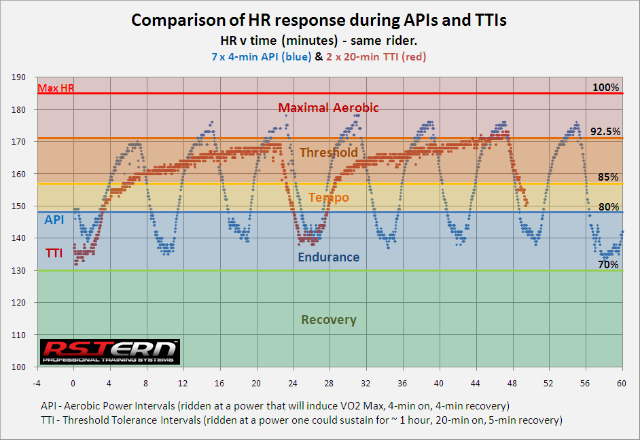Functional Threshhold HR as % of max HR
Nellyspania
Posts: 71
Hi all, I've been cycling for many years but recently became more interested in HR and got a HR monitor.
I did a 30min threshold HR test at the weekend as per https://www.britishcycling.org.uk/zuvvi/media/bc_files/sportivetrainingplans/THRESHOLD_TEST.pdf and basically got a nice flat line average of 180 BPM for the test.
The only issue is that the zones that the calculator provides gives the start of zone 5 (VO2 max) for me as 189.
The only thing is that is 1BPM from the absolute maximum HR I can achieve on the bike.
Is it unusual to see FTHR at 95% of maximum HR; and for VO2 intervals should I be aiming instead at top end of zone 4?
Cheers
I did a 30min threshold HR test at the weekend as per https://www.britishcycling.org.uk/zuvvi/media/bc_files/sportivetrainingplans/THRESHOLD_TEST.pdf and basically got a nice flat line average of 180 BPM for the test.
The only issue is that the zones that the calculator provides gives the start of zone 5 (VO2 max) for me as 189.
The only thing is that is 1BPM from the absolute maximum HR I can achieve on the bike.
Is it unusual to see FTHR at 95% of maximum HR; and for VO2 intervals should I be aiming instead at top end of zone 4?
Cheers
0
Comments
-
If you can manage 180 for 30 mins I'd suggest you should be able to hit 189 during a paced 4 minute flat out effort.Insta: ATEnduranceCoaching
ABCC Cycling Coach0 -
What you're discovering is that trying to measure a 'functional threshold HR' and trying to use it to set training zones is pretty much a waste of time.
If you did a 30-minute effort at a constant power in the region of your function threshold power then your HR would gradually rise throughout the effort. So trying to measure a functional threshold HR and use it for anything is fairly pointless.
For VO2max intervals aim to do the hardest, constant-power effort you can for the duration of the interval. If you can't measure power then use speed or perceived effort to judge as even an effort as you can.
Ruth0 -
I don't see the point of doing these tests with a HR monitor, as you could test yourself today and then test yourself again in 6 months and chances are your HR for each test will be the same.
To determine your zones you could either do a ramp test to give you your max HR (roughly) or do some some really hard hill sprints which will hopefully get you close to your max HR.
Bear in mind for short intervals your HR may not get to the correct zone for the effort you put in due to lag.0 -
HR is useful for many reasons, HR zones for prescriptive training not so much. I don't even look at HR in my Vo2Max efforts (or shorter duration) during the effort, unless my PE or watts is so far off what I think it should be, then I look at HR to see if I can determine why.
If you averaged 180bpm for the last 20 min of a 30 min effort, that would put that number at the top of the threshold/Z4 zone (as per Friel) and yes you probably could hit 189 for a 5 min effort. However that would depend on a number of things like time of day, amount of warmup, rested-ness, etc. I'd say get your PE (perceived effort) dialled in for 5 min efforts and then use the HR as a descriptor of those efforts rather than an "aim" if you see what I mean.0 -
Thanks all for replies, would I be right then assuming using heart rate for training is of limited value?
I have found it useful for commuting as I have a 26 mile round trip most days and was getting quite fatigued towards the end of the week; having a low 'zone' to aim for rather than speed was helping with that as I have never been that great at judging effort.0 -
BeaconRuth wrote:
For VO2max intervals aim to do the hardest, constant-power effort you can for the duration of the interval. If you can't measure power then use speed or perceived effort to judge as even an effort as you can.
Ruth
Thanks, will try that.0 -
HR is good for longer endurance rides if you have your zones dialled in right.
There's a lot to be said for rate of perceived exertion. I use power for my sweetspot or threshold intervals. Vo2 Max and above and 10 mile TTs , purely RPE.Insta: ATEnduranceCoaching
ABCC Cycling Coach0 -
Nellyspania wrote:Thanks all for replies, would I be right then assuming using heart rate for training is of limited value?
I have found it useful for commuting as I have a 26 mile round trip most days and was getting quite fatigued towards the end of the week; having a low 'zone' to aim for rather than speed was helping with that as I have never been that great at judging effort.
It has limitations, just need to be aware of them.
Using it to keep yourself out of the red on commutes or to keep yourself honest when you're supposed to be working hard is fine. I use it for longer intervals on the turbo (as don't have a PM).
But agree with above that for hard intervals (VO2) it seems to be better to just go by RPE (as HR takes a while to come up, and also there's not that much difference between the levels at the top end if you calculate by %MHR)0


